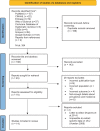Prevalence and incidence of venous leg ulcers-A systematic review and meta-analysis
- PMID: 37293810
- PMCID: PMC10588327
- DOI: 10.1111/iwj.14272
Prevalence and incidence of venous leg ulcers-A systematic review and meta-analysis
Abstract
Venous leg ulcers (VLU) represent a major public health challenge. Little is known about the prevalence and incidence of VLU internationally. Published studies are usually reporting different estimates because of disparities in study designs and measurement methods. Therefore, we conducted a systematic literature review and meta-analysis to identify the prevalence and incidence of VLU internationally and to characterise the population as reported in these studies. Studies were identified from searches in Medline (PubMed), CINAHL Complete (EBSCOhost), Embase, Scopus, Web of Science, LiSSa (Littérature Scientifique en Santé), Google Scholar and Cochrane Database of Systematic Reviews up to November 2022. Studies were included if their primary outcomes were reported as a period prevalence or point prevalence or cumulative incidence or incidence VLU rate. Fourteen studies met the inclusion criteria, 10 reporting estimates of prevalence, three reporting both prevalence and incidence estimates and one incidence. All were included in meta-analyses. The results show a pooled prevalence of 0.32% and a pooled incidence of 0.17%. Our results highlighted an extreme heterogeneity across effect sizes for both prevalence and incidence, which prevent a meaningful interpretation of pooled indexes and argue for further studies with specific prevalence-type reported and target population under study.
Keywords: incidence; meta-analysis; prevalence; systematic review; venous leg ulcer.
© 2023 The Authors. International Wound Journal published by Medicalhelplines.com Inc and John Wiley & Sons Ltd.
Figures
Similar articles
-
Oral aspirin for treating venous leg ulcers.Cochrane Database Syst Rev. 2016 Feb 18;2(2):CD009432. doi: 10.1002/14651858.CD009432.pub2. Cochrane Database Syst Rev. 2016. PMID: 26889740 Free PMC article.
-
Dressings and topical agents for treating venous leg ulcers.Cochrane Database Syst Rev. 2018 Jun 15;6(6):CD012583. doi: 10.1002/14651858.CD012583.pub2. Cochrane Database Syst Rev. 2018. PMID: 29906322 Free PMC article.
-
Compression for venous leg ulcers.Cochrane Database Syst Rev. 2012 Nov 14;11(11):CD000265. doi: 10.1002/14651858.CD000265.pub3. Cochrane Database Syst Rev. 2012. PMID: 23152202 Free PMC article.
-
Hydrogel dressings for venous leg ulcers.Cochrane Database Syst Rev. 2022 Aug 5;8(8):CD010738. doi: 10.1002/14651858.CD010738.pub2. Cochrane Database Syst Rev. 2022. PMID: 35930364 Free PMC article.
-
Protease activity as a prognostic factor for wound healing in venous leg ulcers.Cochrane Database Syst Rev. 2018 Sep 1;9(9):CD012841. doi: 10.1002/14651858.CD012841.pub2. Cochrane Database Syst Rev. 2018. PMID: 30171767 Free PMC article.
Cited by
-
A qualitative exploration of the barriers and facilitators to early lower limb assessment and onward referral for specialist treatment for patients with venous ulceration.Int Wound J. 2025 Jan;22(1):e70071. doi: 10.1111/iwj.70071. Int Wound J. 2025. PMID: 39800354 Free PMC article.
-
Assessing the Safety, Tolerability and Efficacy of Cell-Free Amniotic Fluid in the Treatment of Non-Healing Venous Ulcers: Initial Experience From a Prospective, Multicenter, Phase II Study.Int Wound J. 2025 Apr;22(4):e70171. doi: 10.1111/iwj.70171. Int Wound J. 2025. PMID: 40129130 Free PMC article. Clinical Trial.
-
Gold Nanoparticles for Wound Healing in Animal Models.Nanomaterials (Basel). 2025 Aug 8;15(16):1213. doi: 10.3390/nano15161213. Nanomaterials (Basel). 2025. PMID: 40863793 Free PMC article. Review.
-
Chronic venous insufficiency and venous leg ulcers: Aetiology, on the pathophysiology-based treatment.Int Wound J. 2023 Oct 19;21(2):e14405. doi: 10.1111/iwj.14405. Online ahead of print. Int Wound J. 2023. PMID: 37858977 Free PMC article.
-
Healing Rate and Time to Closure of Venous Leg Ulcers: A Real-World Service Evaluation of Neuromuscular Electrostimulation as an Adjunct to Compression Therapy.Adv Skin Wound Care. 2025 Jun 1;38(5):246-250. doi: 10.1097/ASW.0000000000000299. Epub 2025 Apr 1. Adv Skin Wound Care. 2025. PMID: 40184497 Free PMC article.
References
-
- Santler B, Goerge T. Chronic venous insufficiency – a review of pathophysiology, diagnosis, and treatment. J Dtsch Dermatol Ges. 2017;15(5):538‐556. - PubMed
-
- Körber A, Jockenhöfer F, Sondermann W, Stoffels‐Weindorf M, Dissemond J. First manifestation of leg ulcers: analysis of data from 1000 patients. Der Hautarzt. 2017;68(6):483‐491. - PubMed
-
- Körber A, Klode J, Al‐Benna S, et al. Etiology of chronic leg ulcers in 31,619 patients in Germany analyzed by an expert survey. J Dtsch Dermatol Ges. 2011;9(2):116‐121. - PubMed
-
- Rajhathy EM, Murray HD, Roberge VA, Woo KY. Healing rates of venous leg ulcers managed with compression therapy: a secondary analysis of data. J Wound Ostomy Continence Nurs. 2020;47(5):477‐483. - PubMed
-
- Abbade LPF, Lastoria S. Venous ulcer: epidemiology, physiopathology, diagnosis and treatment. Int J Dermatol. 2005;44(6):449‐456. - PubMed
Publication types
MeSH terms
LinkOut - more resources
Full Text Sources
Research Materials
Miscellaneous






